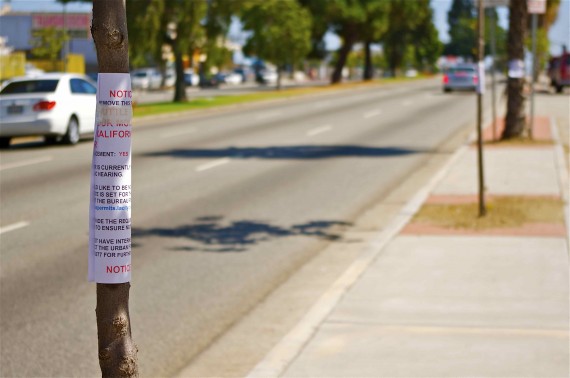When I first reported on the notices posted on trees along Crenshaw Blvd. back in July, I did not realize that those notices were more or less the extent of the outreach the Science Center had done with the communities that the Space Shuttle Endeavour would be traveling through.
Speaking with KCRW's Saul Gonzalez last week, Leimert Park neighborhood council member Lark Galloway-Gilliam said that she had only found out about the planned cutting of the trees by accident. The Science Center, where the Shuttle will be housed, never contacted the communities directly to let them know or discuss their plans.
The oversight was disrespectful, many felt, not only given the detrimental impact to the property values that the loss of old trees would have, but also because of the emotional value of the trees for the community. Fourteen of those originally slated for removal had been planted in January of 1990 by community members as part of a memorial to Dr. Martin Luther King. Twenty-two years later, they now stand over forty feet high, in large part because of the care that community members dedicated to them every month.
Moreover, there was no study of the environmental impact, noted Galloway-Gilliam, despite the fact that 400 trees were on the chopping block in park-poor communities with high asthma rates. Something cyclists will no doubt find ironic, given that the striping of bike lanes -- a benefit to the environment -- can be held up because of environmental impact concerns.
The L.A. Times reports that the Science Center was finally given the green light to remove the nearly 400 trees (119 of which are in South Los Angeles) after a three-hour Public Works meeting yesterday at City Hall.
The advocacy efforts of the affected communities pushed the Science Center to promise more benefits to residents.
It has agreed to repair sidewalks and hire local youths for at least half of the tree maintenance jobs. The Times also reports they will offer "10 scholarships to area students and pay $100,000 to an education fund and train local teachers in science."
With regard to the trees, instead of doing the minimum required replanting of two trees for every one taken out, the Science Center will plant four in South L.A. (although, they will still plant two for every one in Inglewood and other communities). They agreed the new trees would be sturdier than new saplings and plan to cover the costs of maintenance and trimming for five years instead of two. Those concessions will hopefully help to ensure the trees survive and thrive in their new environments. Nationally, Andy Lipkis of Tree People said on Which Way L.A., vandalism, failure to water, and the overall harsh conditions of an urban setting doom most trees to a life span of just 6 years.
Tree removal could begin as early as next week. The 119 trees (and three transplants) on the chopping block (as cited in a list provided to the Leimert Park Beat by Galloway-Gilliam) are the following:
SUMMARY BY TREE TYPE / TREATMENT (DESCRIPTION, QUANTITY)Large Intrusive Tree / Removal 19Large Tree / Removal 22Small Tree / Removal 78Small Tree / Transplant 3Total Trees: 122
SUMMARY BY SPECIES (DESCRIPTION, QUANTITY)Callistemon citrinus 4Ceratonia siliqua 3Cercis occidentalis 1Cupaniopsis anacardioides 4Eucalyptus 12Ficus microcarpa nitida 8Hibiscus 1Liquidambar styraciflua 1Magnolia grandiflora 41Pinus canariensis 4Platanus acerifolia 11Podocarpus gracilior 5Pyrus kawakamii 4Washingtonia robusta 23Total Trees: 122
Trees Over 15' Height and 10" Caliper 43Other Trees 79







